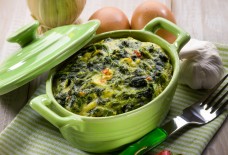You’re Going to Fall in Love with Kushari, the National Dish of Egypt
SOURCE: CHOWHOUND
BY: ALYSSA JUNG
Unless you’re Egyptian (or frequent Egyptian or Middle Eastern restaurants), you probably haven’t heard of kushari (sometimes spelled koshary or koshari). But, expect to see this unique menu item—which happens to be the national dish of Egypt—finding its way into the spotlight more and more. That’s thanks, in part, to an increasing number of restaurants serving up this simple yet deliciously exotic delicacy in big cities across the country. We asked Mohamed Momen, chef and owner of Kusharista, the New Jersey-bound Kushari specialist that opened in New York last year, to break down his country’s signature dish.
First, a quick history lesson
You’ve got to know the story behind kushari to really understand how a mish-mash dish became popular enough to represent an entire culture and nation. Traditional kushari is comprised of rice, al dente macaroni, lentils, chickpeas, and tomato sauce, then topped with fried onions and a garlic vinegar sauce. Perhaps unsurprising once you see the ingredient list, three different countries each contributed a piece of the culinary puzzle: India is behind the rice, lentils, and chickpeas; Italians working in the restaurants of Egypt added pasta and tomato sauce; and Egyptians themselves topped it all off with those crispy onions and a bright, vinegary sauce to tie it all together. “It’s three different cultures altogether in one meal,” says Momen.
Kushari was originally sold as street food before becoming the crown jewel of brick and mortar shops all over Egypt—in fact, the late Anthony Bourdain, always a champion of quirky culinary gems, once shot an episode in Egypt where he enjoyed kushari from one of the most famous restaurants in Cairo.
Now, on to the flavors
The ingredient roster is random, but somehow they all work together. Authentic kushari starts with a base of rice and lentils, then gets a scoop of plain ol’ macaroni, a spoonful of savory chickpeas, a dousing of cumin-spiced tomato sauce, a heavy sprinkling of crispy fried onion strings, and a drizzle of garlicky vinegar sauce (sometimes accented with a hint of lemon). Extra tomato sauce, vinegar, onions, and chili sauce are sometimes served on the side. “The spices are very basic—just cumin, salt and pepper, and lemon—so it’s not overpowering or overwhelming,” says Momen.
It’s a healthy meal…like, really healthy
Traditional kushari is high in protein, fiber, good carbs, and is vegan. Perhaps that’s why the hardworking Egyptian folks ate it almost every day for lunch. “It’s inexpensive and a high source of nutrients, so it would give them energy to continue working all day,” says Momen.
Today, American restaurateurs like Momen are putting their own spin on the dish (while preserving its authenticity with the theme of the ingredients) to make it even healthier. You can find the traditional dish on the menu of pretty much any Egyptian restaurant. But at places like Kusharista, whose sole focus is kushari, your bowl is completely customizable, right on the spot—choose from whole grain rice and pasta options, then pile on extra toppings of veggies, nuts, and even meat or fish for when you really need to fuel up. Say “hello” to your new favorite grain bowl you didn’t know you needed!
Try this koshari recipe for starters, or the one in Anissa Helou’s “Feast” cookbook.



